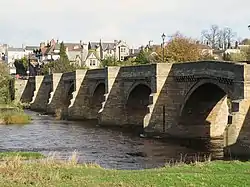
The Great Flood of 1771 affected several rivers, including the Tyne, Tees, Wear and Eden and settlements across northern England from 16 and 17 November 1771.[1] Its cause was a sudden thaw of the ice in upper Teesdale, a cloud burst over the Pennines and a continuous period of rain.[2]
On the River Tyne at Newcastle upon Tyne the middle arch and two of the arches near the Gateshead side collapsed in the early hours of November 17.[3][4] Like many bridges of the time there had been houses and shops on the bridge.[3][1] Upstream, most of the village of Styford on the north bank was destroyed.[1] In total, 25 people died and thirteen or fourteen bridges, including Hexham Bridge, were destroyed on the North, South and main Tyne rivers.[5]
On the River Wear in the city of Durham three arches of Elvet Bridge were destroyed,[1] and Prebends Bridge of 1574 was swept away.[6][7] Further downstream the city's Corn Mill was badly damaged and needed to be rebuilt.[8]
On the River Tees mills and houses were lost, and the river was reportedly 0.5 miles (0.8 km) wide at Low Coniscliffe.[1] Yarm was one of the areas worst affected, as the river burst its banks in several places. Some stretches of the High Street were submerged in 20 feet (6.1 m) of water.[2] According to reports, the whole of Yarm lay underwater, every building was affected, six houses were destroyed and many more left uninhabitable.[9] The Shambles was washed away and the town's main church was also damaged. Nine of the townspeople also died.[2]
To the west, the River Eden also rose and affected Carlisle and Botcherby Mill, flooding the church.[10] as did Solway Moss, flooding local farms and settlements.[11]
References
- 1 2 3 4 5 "Great Flood of 1771". University of Newcastle. Retrieved 22 February 2021.
- 1 2 3 "The Great Flood of Yarm - 1771". Stockton-on-Tees Borough Council. Retrieved 22 February 2021.
- 1 2 Needle, Emily (22 November 2015). "How the 'Great Flood' of Newcastle destroyed the old Tyne Bridge in 1771". Newcastle Chronicle. Retrieved 22 February 2021.
- ↑ "Newcastle". Newcastle Courant. 23 November 1771. p. 2.
- ↑ "Floods are part of the River Tyne's nature". Hexham Courant. 16 December 2016. Retrieved 22 February 2021.
- ↑ "Prebends Bridge". University of Newcastle. Retrieved 22 February 2021.
- ↑ "The city of Durham: Rivers, bridges and mills". British History Online. Retrieved 22 February 2021.
- ↑ "Inheriting an 18th century landscape". Durham Cathedral. Retrieved 22 February 2021.
- ↑ "Chronology of British Hydrological Events". British Hydrological Society. Retrieved 23 February 2021.
- ↑ Candlin, Alex (12 December 2020). "Roger Bingham on the Westmorland winter floods of 1771". Retrieved 22 February 2021.
- ↑ McEwen, Lindsey J.; Withers, Charles W. J. (1989). "Historical records and geomorphological events: the 1771 'eruption' of Solway Moss". Scottish Geographical Magazine. 105 (3): 149–157. doi:10.1080/14702548908554428.
Further reading
- Rennison, R.W. "The Great Inundation of 1771 and the Rebuilding of the North-East's Bridges" (PDF). Newcastle Antiquaries.